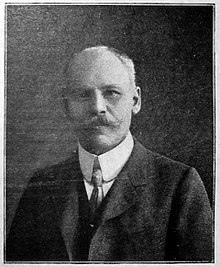Fritz Baare
Fritz Baare (born May 9, 1855 in Bochum , † April 10, 1917 in Bad Oeynhausen ; full name: Friedrich August Baare ) was a German company manager and industrialist .
The son of the Bochum industrialist Louis Baare finished his schooling in Arnsberg in 1873 with the final examination and then studied in Berlin and Karlsruhe . He also improved his technical and language skills by spending several months in Paris and two years in Leeds (England).
On May 1, 1880, he entered the service of the Bochum Association , where he worked as his father's deputy. On August 19, 1882, he married Hedwig Wilhelmine Heintzmann (* July 21, 1861; † November 18, 1948), a daughter of the Bochum mountain council Heintzmann, who did a lot for numerous social institutions. With her he had two daughters.
On January 5, 1895, Fritz Baare succeeded his father as General Director of the Bochum Association. Unlike the latter, however, he had hardly any political ambitions, but was primarily concerned with the interests of the company. He made a name for himself in the professional world of that time, in particular with the construction of one of the first hydraulic 4,000 t forging presses built in Germany . In addition, he was second chairman of the Bochum Chamber of Commerce and from 1905 to 1916 a member of the Westphalian provincial parliament for the constituency of Bochum-Stadt and the National Liberal Party .
Fritz Baare was awarded the honorary title of Privy Councilor of Commerce in 1907 and an honorary doctorate (as Dr.-Ing. E. h.) From the Technical University of Aachen in July 1914 because of his services . The avenue leading to the colliery of the same name in the Teutoburgia settlement was named after him as Baarestrasse.
Fritz Baare succumbed to the long-term effects of a heart attack, which already severely restricted him in the last years of his life. His grave is in the Baare family crypt in today's Bochum Kortumpark . His successor as general director of the Bochumer Verein was his younger brother Wilhelm Baare (1857-1938).
literature
- Stahl und Eisen , 37th year 1917, No. 18 (from May 3, 1917), p. 54f. (Obituary)
- Conrad Matschoss : men of technology. VDI-Verlag, Berlin 1925.
- Marco Rudzinski: Heavy industrial company and municipality. A contribution to a neglected area in the company's history. In: Accumulation, information from the working group for critical corporate and industrial history , No. 22 (2005) (online as a PDF document with approx. 238 kB) , pp. 29–44.
- Josef Häming: The Members of the Westphalia Parliament: 1826–1978, 1978, Westphalian sources and archive directories; Vol. 2 (main volume), p. 165.
Individual evidence
- ↑ Marriage note from the church records 1672–1905 of the Protestant Church in Bochum
- ^ Dates of life according to the tombstone of the Baare family crypt
- ^ Bochum women - biographical sketches: Hedwig Baare on the website of the city of Bochum, last accessed on May 25, 2011
- ↑ Manfred Hildebrandt [edit.]: Herne - from Ackerstraße to Zur-Nieden-Straße: City history in the mirror of street names . Ed .: Stadt Herne, Der Oberbürgermeister (= Publications of the City Archives Herne . Volume 1 ). Herne 1997.
| personal data | |
|---|---|
| SURNAME | Baare, Fritz |
| ALTERNATIVE NAMES | Baare, Friedrich August (full name) |
| BRIEF DESCRIPTION | German manager and industrialist |
| DATE OF BIRTH | May 9, 1855 |
| PLACE OF BIRTH | Bochum |
| DATE OF DEATH | April 10, 1917 |
| Place of death | Bad Oeynhausen |
